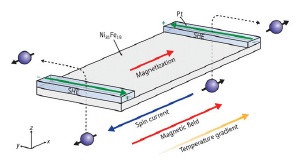Feb 5 2009
Modern electronics is based on the transport of electrons, generated by a difference in electric voltage. In a bid for faster and smaller electronic devices, researchers have turned to the spin of electrons, or spintronics. However, sustaining spin currents has proven difficult. Now researchers from the RIKEN Advanced Science Institute in Wako with scientists from Keio University, Yokohoma, and Tohoku University, Sendai, have-for the first time-observed the so-called spin Seebeck effect, which is able to generate pure spin currents across macroscopic distances.
 Schematic of the experimental setup for the spin Seebeck effect. A magnetic metal such as Ni81Fe19 is exposed to two different temperatures at its ends. With the magnetic magnetization (red arrow) in the plane of the device, a spin voltage results, so that spins of different orientation are at either ends of the sample. The spin voltage is measured through thin platinum (Pt) strips where the spin Hall effect (SHE) converts spin voltages into electric voltages.
Schematic of the experimental setup for the spin Seebeck effect. A magnetic metal such as Ni81Fe19 is exposed to two different temperatures at its ends. With the magnetic magnetization (red arrow) in the plane of the device, a spin voltage results, so that spins of different orientation are at either ends of the sample. The spin voltage is measured through thin platinum (Pt) strips where the spin Hall effect (SHE) converts spin voltages into electric voltages.
The classic Seebeck effect describes the generation of an electric voltage when the ends of a material are at different temperatures. As such, it is used in thermoelectric devices that convert heat into electricity.
In a similar fashion, as reported by the researchers in Nature*, the spin Seebeck effect reported uses a temperature gradient in a magnetic material to create a flow of electron spins in the absence of any external voltage. As a result, spins of opposite polarization assemble at the two ends of the sample, creating a ‘spin voltage’ caused by the different spin polarizations at both ends. This use of thermal effects in spintronics is novel and unexpected. “The electron spin is usually controlled by magnetic fields, so nobody has thought about a thermoelectric response,” says Wataru Koshibae from the research team.
The discovery of the spin Seebeck effect is enabled by the so-called spin Hall effect. Through interactions between the spin current and the atoms in a metal, electrons of different spin orientations get scattered to opposite ends of the metal, creating an electrical voltage. The spin voltage created by the spin Seebeck effect is then detected by thin platinum sheets placed at both ends of the sample.
Importantly, in this setup the electrons don’t move at all, and only spins travel along the sample. This is markedly different to most other schemes where undesirable parallel electronic currents are unavoidable. In addition, there appears to be no limit to the distances along which spin currents can be sustained. “The spin Seebeck effect occurs in samples almost 1 cm long, much longer than the usual spin current decay lengths of 1 nm,” comments Koshibae.
This first observation of the spin Seebeck effect therefore marks a new era in spintronics and opens the door to novel applications. Long-distance spin current are critical to the realization of spintronic devices, and these results offer the generation of spin currents simply through temperature effects.
*Uchida, K., Takahashi, S., Harii, K., Ieda, J., Koshibae, W., Ando, K. Maekawa, S. & Saitoh, E. Observation of the spin Seebeck effect. Nature 455, 778–781 (2008).
The corresponding author for this highlight is based at the RIKEN Theoretical Design Team